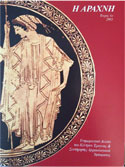MARCH'S WORD: HISTOS
Λήκυθος ΝΥ ΜΕΤ Public Domain.jpg

Amasis lekythos MET |www.artextiles.org
Almost all Indoeuropean languages share the Proto-Indoeuropean root *sti-stéh2, and among them of course the Greek, in the athematic verb with reduplication: si-stéh2-mi > hίστᾱμι > ἵστημι, pass. ἵσταμαι. It is mentioned since the Mycenean times, ἱστιάων, ἱστόϝεσσα and in the Classical period, there is a whole groupe of composita with almost every preposition, as well as derived words, στατήρ, στήμων, στάσις, σταθμός, στάμνος, στήλη, σταυρός, στάδιον, -στάτης, -στασ(ε)ία, -στημα etc. and of course ἱστός, the loom.
The term ἱστός does not derive from ἵστημι but from ἵσταμαι, it is something standing upright on its own and not something that makes something else stand up. It refers to the vertical beams (ἱστόποδες) that support from both sides the frame of the loom, and which gave their name both to the loom itself and its product, the fabric.
The term has evolved in two directions:
1. in its original context: ἱστεών, place were the loom stands, weaving workshop,
2. in the naval terminology: ἱστός is the mast of the ship, hence ἱστο-δόκη (support for the mast when let down), ἱστο-πέδη (hole in the keel for stepping the mast), ἱστοκεραία and most importantly ἱστίον (mostly in plural, τὰ ἱστία, sailcloth), ἱστιοῤῥάφος (sail-maker) etc.
The semantic use of the term is very large, in English translated with the term “web” or “tissue”, e.g. anatomy (epithelial tissue), spider’s web, world wide web, website etc.


